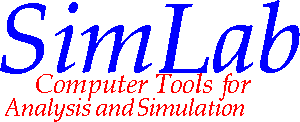
This is the initial release of the SimLab software. This release includes mathematical functionality for algebraic and topological computations (Weyl), as well as code (using Weyl) for creating guaranteed-quality triangulations of planar areas.
Implemented using the Common Lisp Object System (CLOS) in Common Lisp, the release is available by ftp as a compressed (gzip) tar file (633820 bytes) together with a plain text file "README-1-0" (4732 bytes) that describes how to install the software. These are files are available via FTP at the site ftp.cs.cornell.edu in the directory /pub/simlab/release/ as README and simlab.tar.gz
The process of creating a guaranteed quality mesh is illustrated in the following figures. The first figure illustrates the input. The boundary of the region is drawn in black, while the region for which a mesh is required is the area shown in green.

The guaranteed quality mesh created by the automatic mesh generator is shown below:

For more information on this use of the SimLab software, see the MADEFAST pages.
All code is copyrighted Cornell University, 1995.
This code has been developed by Paul Chew, Paul Jackson, Sekhar Muddana, Rick Palmer, Todd Wilson and Richard Zippel in the Simlab group at Cornell University. This material is NOT in the Public Domain, but permission to copy this software, to redistribute it, and to use it for any purpose is granted, subject to the restrictions and understandings described in the README file contained in the distribution.
This work was supported in part by the Advanced Research Projects Agency of the Department of Defense under ONR Contract N00014-92-J-1989, by ONR Contract N00014-92-J-1839, and in part by the U.S. Army Research Office through the Mathematical Science Institute of Cornell University.
Rick Palmer / rick@cs.cornell.edu